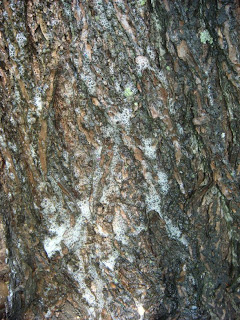"Luna"cy at Smugglers' Notch
 by Eric Bouchard, Assistant Ranger Smugglers' Notch
by Eric Bouchard, Assistant Ranger Smugglers' NotchEver so gracefully do these winged creatures of the night,
Flutter and soar in the pale moonlight,
With brilliant shade of green this creature doth glow,
And dance fancy free for the evening show.
~EWB
Smugglers' Notch has attracted some bizarre, yet stunning visitors to the park as of late. These visitors of whom I speak, are not our campers, but a species of moth that is unlike anything I, personally, have ever seen before. The species to which I am referring is the Luna Moth.
Seen left, the Luna Moth (a.k.a. the Giant Silkworm Moth) with its brilliant pale green wings, a white body, and pinkish legs, sports an impressive wingspan that can reach 4 ½ inches. Once common throughout the US, sightings of this beautiful creature have diminished due to spikes in pollution and habitat loss..jpg)
Females, who lay their eggs, roughly 200, on the underside of black walnut tree leaves, live long enough for that purpose only. In fact, the adult Luna Moth has one primary objective in its short five-day life cycle, to mate. Finding food is of little use to this creature as its mouth is non-existent in this life-stage.
Though this stage in their life-cycle is extremely brief, it is the caterpillar stage that grants these creatures more of an opportunity to experience the world. Ten days after the eggs are laid, they emerge and begin immediately feeding on the leaves of sweetgum, American beech, red maple, hickory, white oak, black cherry, willow, American chestnut, and smooth sumac.

Over a three-to-four-week period the caterpillars continue to develop. They outgrow their skin five times within that period and molt the excess. After reaching full maturity the caterpillar will be roughly 2 ½ inches long and will then begin cocooning itself within a silk encapsulated leaf. After breaking free from its transformation chamber the beautiful moth emerges.
Rest strengthens the moth for its first flight,
Though is not yet time to fly towards the light,
After wings inflate and blood flows through,
It is now time to begin the cycle anew.
Reference: http://www.fcps.edu/islandcreekes/ecology/luna_moth.htm
Flutter and soar in the pale moonlight,
With brilliant shade of green this creature doth glow,
And dance fancy free for the evening show.
~EWB
Smugglers' Notch has attracted some bizarre, yet stunning visitors to the park as of late. These visitors of whom I speak, are not our campers, but a species of moth that is unlike anything I, personally, have ever seen before. The species to which I am referring is the Luna Moth.
Seen left, the Luna Moth (a.k.a. the Giant Silkworm Moth) with its brilliant pale green wings, a white body, and pinkish legs, sports an impressive wingspan that can reach 4 ½ inches. Once common throughout the US, sightings of this beautiful creature have diminished due to spikes in pollution and habitat loss.
.jpg)
Females, who lay their eggs, roughly 200, on the underside of black walnut tree leaves, live long enough for that purpose only. In fact, the adult Luna Moth has one primary objective in its short five-day life cycle, to mate. Finding food is of little use to this creature as its mouth is non-existent in this life-stage.
Though this stage in their life-cycle is extremely brief, it is the caterpillar stage that grants these creatures more of an opportunity to experience the world. Ten days after the eggs are laid, they emerge and begin immediately feeding on the leaves of sweetgum, American beech, red maple, hickory, white oak, black cherry, willow, American chestnut, and smooth sumac.

Over a three-to-four-week period the caterpillars continue to develop. They outgrow their skin five times within that period and molt the excess. After reaching full maturity the caterpillar will be roughly 2 ½ inches long and will then begin cocooning itself within a silk encapsulated leaf. After breaking free from its transformation chamber the beautiful moth emerges.
Rest strengthens the moth for its first flight,
Though is not yet time to fly towards the light,
After wings inflate and blood flows through,
It is now time to begin the cycle anew.
Reference: http://www.fcps.edu/islandcreekes/ecology/luna_moth.htm

.jpg)
.jpg)
wow i finally see it my own eyes never seen it in my life i saw it stay on my tree in front yard and i image it look like it glows at night until i look up in reachsearch and it was true but wow it big and amazing
ReplyDelete